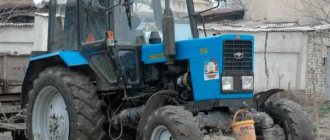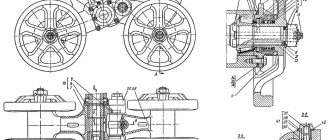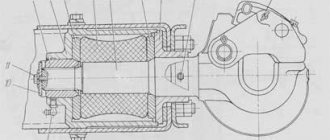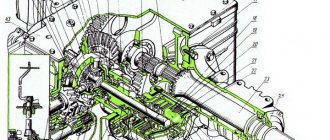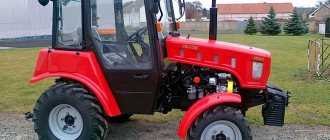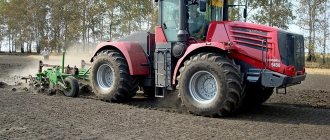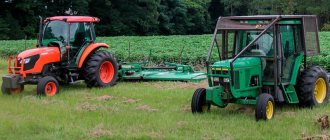The T-16 chassis includes a front axle with guide wheels and rear drive wheels. Its design makes it possible to obtain a variable track for the operation of the unit in various row spacings, maintaining clearance and protective zones. The main functions of the front axle are to provide support for the front part of the frame and to allow the steering wheels to turn along with the steering linkage.
The swing of the balancing mechanism in the vertical plane is ensured by the articulated connection of the front axle and the frame. This allows the front wheels to adapt to uneven surfaces independently of the rear wheels. The balancing device consists of a balancer (Figure 1, item 38) and steering knuckle housings inserted into it (item 31). The balancer is made in the form of a steel pipe, to which the swing axis bracket is welded in the middle part.
The swing axis of the T-16 tractor (pos. 36) is mounted in the holes of the balancer bracket and is secured against radial and axial movement using a wedge (pos. 37). The steering knuckle housings are installed in the balancer pipe on both sides, secured with locking bolts (pos. 28) with nuts (pos. 29) and locknuts. The axle shaft cam (pos. 30) with the front wheel axle shaft rotates in bushings (pos. 32), which are pressed into the vertical plane of the cam housing. A thrust ball bearing (pos. 33) is pressed into the lower part of the knuckle, which supports the knuckle body through the ring (pos. 34). The bushings and thrust ball bearing are lubricated through grease nipples (pos. 26). In order to prevent dirt and dust from entering the bearings, an o-ring (pos. 35) is placed in the lower part of the vertical cavity of the housing.
The hub (pos. 21) of the front wheel rotates on the axis of two roller bearings, which are secured with a castle nut. The disk with the rim (pos. 15) is attached to the wheel hub (pos. 21) with bolts (pos. 17) and nuts (pos. 16) with conical supports. A tire is mounted on the wheel rim (item 14). On the axes of the knuckles, by means of segment keys (item 27) and bolts (Figure 2, item 39), rotary levers (items 40, 50) are fixed, which are connected to each other by an internal rod (item 41). An external rod (pos. 43) connects the lever (pos. 50) to the bipod lever (pos. 1), mounted on the splined surface of the shank of the longitudinal shaft of the steering mechanism.
The rods are similar in design. They are pipes to which clamps (pos. 45) and tips (pos. 42) of ball pins (pos. 13) are welded. The design also includes springs (pos. 8), spherical washers (pos. 10, 11), locks (pos. 9), threaded plugs (pos. 7), oilers (pos. 6), rubber boots (pos. 12) and rods (pos. 44, 49). The rods in the rods are fixed with wedge pins (pos. 46), which are inserted into the holes of the clamps (pos. 45) and pass through the flats of the rods. The threaded ends of the rods are screwed into the lugs (pos. 48), connected to the swing arms through ball pins. The internal cavity of the tips is lubricated through grease fittings (items 6, 47). To protect against dust and dirt, the internal cavity of the tips is protected by rubber covers (item 12). Unified hinges are manufactured with one-time lubrication, so subsequent lubrication is performed only when they are repaired.
The drive wheel of the T-16 tractor chassis is a profiled rim with a low-pressure tire and a steel convex disk. The drive wheels are attached to the axle hub with special bolts and nuts with tapered supports. Ensuring good adhesion of the drive wheels to the ground is achieved by their correct installation. To do this, when installing the rear wheel, you need to make sure that the convex arrow with the inscription “Rotation direction” located on the side surface of the tire coincides with the direction of rotation of the wheel when the tractor moves forward.
T-16/16MG. Universal tractor "beggar"
More than 20 years have passed since the production of the T-16MG ceased, but this tractor is still not uncommon in the vastness of our country, especially in rural areas.
Many people have at least once seen an unusual tractor, usually with a loading platform located in front of the cab. For this feature he received the popular name “beggar”. The second name given by the people was “shassik”.
Initially, the T-16 design was considered as a self-propelled universal chassis for various agricultural units. Since the power was small, it was not suitable for row-crop work, but it was quite suitable for weeding, spraying, forage harvesting, agricultural self-loaders, and haying.
The tractor worked not only in the village, but also in the city, mainly as equipment for road and municipal enterprises - road cleaning, marking, hydraulic lifts and even cranes - there were manipulators built on its basis.
Despite the versatility of this tractor, it was most often used as a rural truck, with a body in front and excellent cross-country ability. The distance from the ground to the lowest point of the tractor is more than half a meter. This distance is called agricultural clearance, by analogy with the ground clearance of a car. Maneuverability was also a big plus.
The carrying capacity is small, 750 kilograms. Yes, and you can’t load much volume, the cab is in the back, but it’s difficult to find another similar truck.
Production of the T-16 began in 1961 in Kharkov. At first, an engine with only 16 hp was installed. This is a two-cylinder, four-stroke, air-cooled diesel engine. It has an interesting feature - pre-chamber mixture formation; there are pre-chamber inserts in the block head. The piston is also not smooth; there is a depression in its bottom.
The 7-speed manual gearbox is also unique - the shafts in it are located transversely relative to the longitudinal axis, and the torque from the engine is transmitted by a bevel gear. This is what it looks like on the diagram.
This design made it possible to make the transmission very compact. The speed range is from 3.7 km/h to 19.5 km/h. There was only one reverse gear. There is also a power take-off shaft.
The steering could be either mechanical or hydraulic, where the front wheels were turned by a hydraulic cylinder.
The T-16 was produced for 6 years, from 1961 to 1967, then the T-16M modification appeared, with a more powerful 25 l/s engine, which expanded the speed range - from 1.6 km/h (a range multiplier appeared) to 23 km/h. This modification also featured a simple frame cabin.
Since the mid-eighties, an updated version of the T-16MG appeared. The engine has been improved, although the power remains the same. The speed increased to 40 km/h, three power take-off shafts appeared, and a more comfortable (if that word even fits it) cabin. The last “beggars” left the factory gates in 1995.
Fig. 1 — Front axle of the T-16 tractor
1 – steering bipod lever; 2, 5 – front wheels; 3 – support washer; 4 – bushing of the swing axis; 6, 24, 26 – oil nipples; 7 – plug; 8 – spring; 9 – lock washer; 10 – small spherical washer; 11 – large spherical washer; 12 – cover; 13 – ball pin; 14 – front wheel tire; 15 – disk and rim of the front wheel; 16 – nut; 17 – bolt; 18 – cargo; 19, 20 – bolt; 21 – front wheel hub; 22 – nut; 23 – cap; 25 – sealing ring; 27 – segmental key; 28 – special bolt; 29 – nut; 30 – axle shaft; 31 – fist body; 32 – bushing; 33 – bearing; 34 – ring; 35 – felt seal; 36 – swing axis; 37 – wedge of the swing axis; 38 – balancer assembly.
HOW I CONVERTED THE T-16 AND OTHER VARIOUS HOMEMADE CX EQUIPMENT AND OTHER THINGS
Here's a photo of what I got! what do you think?
Original)) in principle, I haven’t seen a better option yet, so that’s a pass.
where are the glasses from and what size if possible?
the awning is of great interest
what's under the hood?
And the hood from the Kyrgyzstan lid looks cool!
Under the hood I have a hydraulic tank from the NIVA combine, I removed the fuel tank from the UAZ 452 GUR, I removed the mechanical one from the ZIL 157, a double Bulgarian hydraulic pump, while one pump is working, I will soon install another distributor on the BUCKET loader. I will turn on the second pump. So let's move on. The cab from the KSK 100 is installed back to front . the frame from the manure dispenser in the summer there will be a photo of all the mounted implements, now everything is covered in snow.
Traktou has a 3-hull homemade PLOW with a special harrow. disc harrow. mower from TZ 4K 14 is an excellent mower, 100 times better than our mowers. Hydraulic lift. Rower. Mounted harrow with three harrows. There is a PE 08 loader bucket. I haven’t tested it in operation in the spring. I’ll try to load manure. enough for now .
The homemade frame is secured to the front frame and on the top side on a cable with an adjusting screw. On both sides of the tractor there are screws from the DT 75 swing arms. The side frames are held so that the frame does not fall to the ground.
Modernization of the T-16 tractor
Every person who works in agriculture understands the importance of using auxiliary equipment that will help perform various loading and unloading operations, and also, complete with trailed equipment, will help mechanize various crop, livestock and horticultural tasks . Design engineers, understanding the importance of the task, have long been creating equipment for agriculture that is capable of performing various agricultural work year-round in different climatic conditions, including using sets of mounted and trailed equipment.
From engineering, the tractor is used in agriculture, usually used as a vehicle or tractor. With the help of a tractor, the land is plowed and various non-self-propelled agricultural tools and machines are moved. The tractor, with the help of mounted and trailed engineering devices installed on it, is, in addition to the agricultural industry, also widely used in the construction industry.
Tuning with attachments
Of course, tuning the T-16 tractor often involves replacing auxiliary attachments. These include the following types of equipment:
- cargo dump platform;
- chain saw;
- loaders of different types;
- grader shovel;
- excavator;
- brush for cleaning road surfaces;
- compressor station;
- mowers;
- haystack throwers;
- sprayers;
- etc.
All this together provides the T-16 tractor with a wide range of applications in the construction and agricultural fields. The range of work is very wide, thanks to which the unit has become extremely popular among farmers, rural residents and builders.
It is important that there are no problems in purchasing mounted and trailed equipment for tuning the T-16 tractor, since it can be purchased from specialized companies and even on construction markets. At the same time, the design features, if necessary, make it easy to carry out repair work.
The basis of the T-16 tractor is the DSSh-14 self-propelled chassis. Initially, the structural element was produced at the Kharkov plant. It was supposed to be equipped with a two-cylinder diesel engine with a power of 16 hp. With. Next, the machine was modernized.
Tractor t 16 attachments:
Various types of auxiliary equipment can be installed on the existing mounting points : cargo dump platform, loaders of various types, chain saw, grader shovel, road cleaning brush (installed under the frame), excavator, compressor station, haystack thrower, hay mowers, sprayers, etc. Tractor T- 16 is very convenient for use by agricultural and construction crews. Transporting crops, building materials, driving various agricultural and construction (winch, welding unit, circular saw) mechanisms - this is just a small list of work performed using this tractor. Many farmers and rural residents admit that the T-16 tractor is the most versatile and a useful agricultural mechanism from all available small power tractors.
Spare parts, attachments and trailed equipment for the T-16 tractor are easy to buy on any specialized market, and repairs in the event of a breakdown are inexpensive. Unpretentious to use, easy to repair and very reliable, the T-16 tractor has long won national recognition and affectionate nicknames (“shaitan”, “beggar”, etc.) and is used in many road, municipal enterprises and organizations, as well as in farming and rural households.
The basis for the development of the T-16 tractor was the DSSh-14 self-propelled chassis, which was produced at the Kharkov Self-propelled Tractor Chassis Plant (Ukraine) from 1961 to 1967. It was equipped with a 16 hp diesel two-cylinder engine, the driver's seat was located at the rear, open (without a cabin or canopy). The unit was developed on a chassis frame with space for installing various removable equipment; a haymower and cultivator are located under the frame. It was successfully used in rural areas as a small off-road truck.
A little about the T-16 tractor
Due to the seasonality of agricultural activity, as well as the need to cultivate large volumes of land, the T-16 tractor is subject to a set of specific requirements, which imply the possibility of simple and timely repair and maintenance directly in the field. All trailed and mounted mechanisms must be easily converted.
It is equally important to consider that the T-16 tractor must move at low and relatively high speeds. The model itself was originally supposed to be used on vegetable farms. Therefore, devices such as row-crop cultivators, sprayers, and harvesting mechanisms were used. Installation was not difficult, thanks to which the tractor began to be used for a wider range of work.
Additionally, we should list the modifications of the T-16 tractor, which also became a fragment of tuning on the part of the manufacturer. First of all, there was a change in the cabin, which was previously open and then became closed. This made it possible to transport cargo for various purposes, as well as install new additional equipment.
The main feature of the T-16 tractor is its versatility when working with different types of soil. This is due to the fact that the wheels do not damage the ground surface. These types of damage processes typically occur with most other track-type tractors. At the same time, engine power is used rationally in the special equipment system. There are 3 different power modes.
The plant's design bureau carried out modernization of the T-16 tractor.
-In 1967, the self-propelled chassis was modernized, which received an air-cooled diesel engine with a power of 25 hp, a new gearbox and the designation T-16M; a frame cabin was already installed on it. The load capacity has also increased due to the use of larger wheels. The installed gearbox made it possible to reduce the speed to 1.6 km/h. This advantage made it possible for unlimited use not only in agriculture, but also in other jobs. -Since 1986, they began producing the modernized T-16MG self-propelled chassis, on which a full-fledged cabin and an improved D-21A1 diesel engine were installed, the power remained the same - 25 hp. Improvements have affected many components and mechanisms, and the reliability of the unit has increased. In 1995, production of the T-16MG tractor was discontinued. Further improvement of the self-propelled chassis is carried out only by the owners of the equipment. Their efforts are aimed at producing universal additional equipment that is installed and successfully operated.
